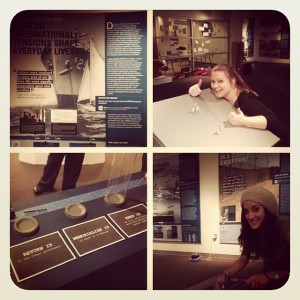Bringing GTMO to GSO: The Road to Opening Night
National Dialogue and Traveling Exhibit
Those of us in the UNCG Public History program who have been working on the Guantánamo Public Memory Project spent the month of November and beginning of December finalizing GTMO & GSO, our cohort’s way of tying the underlying themes of the national traveling exhibit to our community. After months of hard work it was gratifying to hold our first children’s story hour, install flipbooks and polling stations along with the national traveling exhibit, and bring our first round of panel speakers to the International Civil Rights Center and Museum in Greensboro.
Two of my colleagues, Megan Coker and Kimberly Mozingo, wrote wonderful blog posts about what GTMO & GSO entails and about our team’s process. Now that we are a week removed from our exhibit’s opening and our first panel discussion, which I moderated, I would like to reflect on the reactions that our panelists and the public had on our opening night.
The national traveling exhibit and GTMO & GSO opened at the International Civil Rights Center and Museum on Thursday, December 12th. The opening was attended by friends, colleagues, and the general public. As I spoke to people about the exhibit, it became clear that, for most of those in attendance, Guantánamo Bay, Cuba, and post-9/11 detention were practically synonyms. They did not know about the long history of the naval station or the diversity of people who have lived, worked, or been detained there. Visitors took their time going through the exhibit, read panels with great interest, and talked to their fellow visitors about what they were learning. It was phenomenal.
We held the first event in our speaker series, “Voices from Guantánamo,” immediately after the reception. The panel focused on the first-hand accounts of three Americans who had lived at the base: a Seabee, T. G. Daniel, who lived at the base during Castro’s rise to power in the 1950s, and two Navy dependents—Catherine Chapman, who lived at the base during the Cuban Missile Crisis, and Jan Spencer, who lived there during the late 1960s. Their stories, by turns humorous and heart breaking, captivated the audience and gave agency to those who view the base as home. Since we were unable to locate a Cuban who lived at the base to speak on the panel we shared video oral histories recorded by the national project.
Since UNCG focused on the Cold War time period in our panel for the traveling exhibit and spent a lot of time studying life at the base, it was disheartening to learn that many Americans who lived at the naval station have felt that their experiences have been overlooked or even dismissed because of our tendency, as historians and as a society, to emphasize the negative aspects of Guantánamo’s history. It meant so much to our panelists that we provided them with a forum to share their experiences in a way that respected their memories of Guantánamo, without ignoring the atrocities that occurred there. Many American service members and their families have fond memories of the base and the panel reminded us that we should take care to remember that the naval station’s history includes a diversity of stories, not all of them negative.
Posted by Brandie Cline – M.A. Candidate at The University of North Carolina at Greensboro

